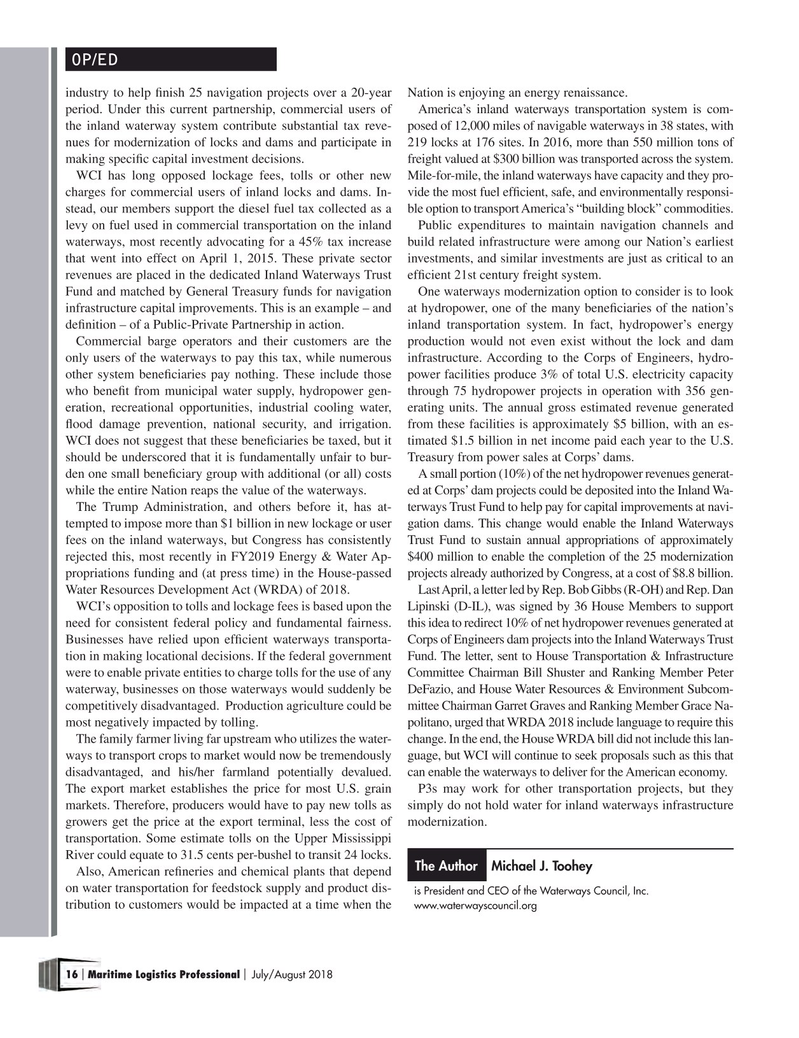
Page 16: of Maritime Logistics Professional Magazine (Jul/Aug 2018)
Port Infrastructure & Development
Read this page in Pdf, Flash or Html5 edition of Jul/Aug 2018 Maritime Logistics Professional Magazine
OP/ED industry to help ? nish 25 navigation projects over a 20-year Nation is enjoying an energy renaissance. period. Under this current partnership, commercial users of America’s inland waterways transportation system is com- the inland waterway system contribute substantial tax reve- posed of 12,000 miles of navigable waterways in 38 states, with nues for modernization of locks and dams and participate in 219 locks at 176 sites. In 2016, more than 550 million tons of making speci? c capital investment decisions. freight valued at $300 billion was transported across the system.
WCI has long opposed lockage fees, tolls or other new Mile-for-mile, the inland waterways have capacity and they pro- charges for commercial users of inland locks and dams. In- vide the most fuel ef? cient, safe, and environmentally responsi- stead, our members support the diesel fuel tax collected as a ble option to transport America’s “building block” commodities. levy on fuel used in commercial transportation on the inland Public expenditures to maintain navigation channels and waterways, most recently advocating for a 45% tax increase build related infrastructure were among our Nation’s earliest that went into effect on April 1, 2015. These private sector investments, and similar investments are just as critical to an revenues are placed in the dedicated Inland Waterways Trust ef? cient 21st century freight system.
Fund and matched by General Treasury funds for navigation One waterways modernization option to consider is to look infrastructure capital improvements. This is an example – and at hydropower, one of the many bene? ciaries of the nation’s de? nition – of a Public-Private Partnership in action. inland transportation system. In fact, hydropower’s energy
Commercial barge operators and their customers are the production would not even exist without the lock and dam only users of the waterways to pay this tax, while numerous infrastructure. According to the Corps of Engineers, hydro- other system bene? ciaries pay nothing. These include those power facilities produce 3% of total U.S. electricity capacity who bene? t from municipal water supply, hydropower gen- through 75 hydropower projects in operation with 356 gen- eration, recreational opportunities, industrial cooling water, erating units. The annual gross estimated revenue generated ? ood damage prevention, national security, and irrigation. from these facilities is approximately $5 billion, with an es-
WCI does not suggest that these bene? ciaries be taxed, but it timated $1.5 billion in net income paid each year to the U.S. should be underscored that it is fundamentally unfair to bur- Treasury from power sales at Corps’ dams. den one small bene? ciary group with additional (or all) costs A small portion (10%) of the net hydropower revenues generat- while the entire Nation reaps the value of the waterways. ed at Corps’ dam projects could be deposited into the Inland Wa-
The Trump Administration, and others before it, has at- terways Trust Fund to help pay for capital improvements at navi- tempted to impose more than $1 billion in new lockage or user gation dams. This change would enable the Inland Waterways fees on the inland waterways, but Congress has consistently Trust Fund to sustain annual appropriations of approximately rejected this, most recently in FY2019 Energy & Water Ap- $400 million to enable the completion of the 25 modernization propriations funding and (at press time) in the House-passed projects already authorized by Congress, at a cost of $8.8 billion.
Water Resources Development Act (WRDA) of 2018. Last April, a letter led by Rep. Bob Gibbs (R-OH) and Rep. Dan
WCI’s opposition to tolls and lockage fees is based upon the Lipinski (D-IL), was signed by 36 House Members to support need for consistent federal policy and fundamental fairness. this idea to redirect 10% of net hydropower revenues generated at
Businesses have relied upon ef? cient waterways transporta- Corps of Engineers dam projects into the Inland Waterways Trust tion in making locational decisions. If the federal government Fund. The letter, sent to House Transportation & Infrastructure were to enable private entities to charge tolls for the use of any Committee Chairman Bill Shuster and Ranking Member Peter waterway, businesses on those waterways would suddenly be DeFazio, and House Water Resources & Environment Subcom- competitively disadvantaged. Production agriculture could be mittee Chairman Garret Graves and Ranking Member Grace Na- most negatively impacted by tolling. politano, urged that WRDA 2018 include language to require this
The family farmer living far upstream who utilizes the water- change. In the end, the House WRDA bill did not include this lan- ways to transport crops to market would now be tremendously guage, but WCI will continue to seek proposals such as this that disadvantaged, and his/her farmland potentially devalued. can enable the waterways to deliver for the American economy.
The export market establishes the price for most U.S. grain P3s may work for other transportation projects, but they markets. Therefore, producers would have to pay new tolls as simply do not hold water for inland waterways infrastructure growers get the price at the export terminal, less the cost of modernization. transportation. Some estimate tolls on the Upper Mississippi
River could equate to 31.5 cents per-bushel to transit 24 locks.
The Author Michael J. Toohey
Also, American re? neries and chemical plants that depend on water transportation for feedstock supply and product dis- is President and CEO of the Waterways Council, Inc. tribution to customers would be impacted at a time when the www.waterwayscouncil.org 16 Maritime Logistics Professional July/August 2018 | | 1-17 MLP JulyAug18.indd 16 1-17 MLP JulyAug18.indd 16 8/8/2018 9:04:58 AM8/8/2018 9:04:58 AM

 15
15

 17
17
